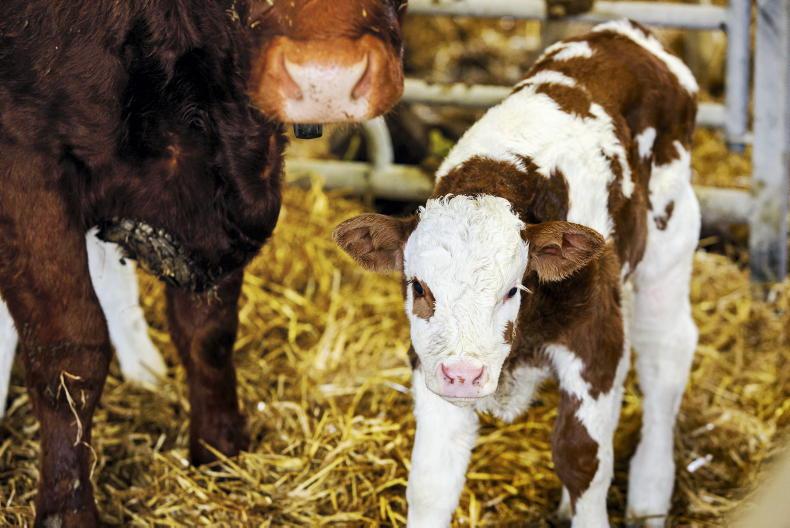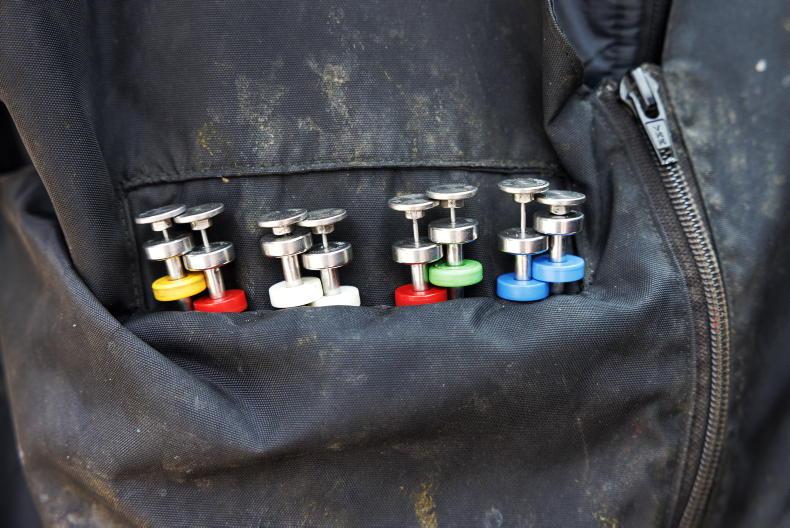On suckler farms where cows calve from early August through the autumn, breeding is due to start towards the end of October.
How well cows are fed and managed during the breeding period has a big bearing on getting animals settled in-calf again.
Outlined are five management areas to focus on.
1. Feed a consistent high-energy diet before and after breeding
Cows should be on a steady diet during the breeding season and for at least four to five weeks after animals have been served to prevent embryonic losses.
If cows have not already been housed, they should be brought indoors to settle on a silage diet now. Housing mid-breeding and the change in diet can have a negative impact on conception rates.
Target the best silage on farm to autumn-calving cows to drive milk production and fertility. Meal should also be fed to boost energy and protein intake, as well as minerals.
For silage at 72DMD or above, feed 1kg/day or 2kg/day if good silage is in limited supply. Increase meal rates by 1kg for every four unit drop in DMD value.
2. Heat detection
With cows housed, heat detection is easier to carry out compared with animals at grass. Where cows are on slats, some animals will display short heats, which can be easily missed.
Tail paint is a low-cost aid to aid heat detection, although other methods are available, some of which are high tech and link to smart phones. Simply locking calves in the creep pen by day can also improve heat activity in cows.
When watching cows, morning and evening are the best times to pick up heats. Spend at least 20 minutes watching cows for signs of heat.
Do not disrupt cows from their natural behaviour when watching for heats, so don’t start pushing in silage when you enter the shed.
3. Get on top of parasite control
After a wet summer and autumn, internal parasites such as fluke pose a challenge to animal health and negatively affect conception rates.
Therefore, treat cows shortly after housing for fluke using a product that targets the parasite at the early immature and mature stages.
With maiden and first-calving heifers, a worm drench may also be required. Remember to treat all cattle for lice also.
4. Flooring options
Slatted floors can be slippy, which limits the level of mounting activity as cows come into heat. There is also a greater risk of animals being injured, particularly stock bulls.
If it is possible, give autumn-calving cows access to sheds with rubber mats or a straw run back to improve traction and increase mounting activity.
5. Minimising stress and safe handling
Keep stress levels to a minimum when handling cows for indoor breeding, particularly when using AI.
Be mindful of your own safety, and the safety of anyone helping out, as cows are removed from pens for breeding.
Cows can become aggressive when separated from their calf. Ideally, bring the calf with the cow when safe to do so. Bringing a couple of cows can be safer than trying to isolate one animal.
Move cows direct to a handling unit and inseminate, then return to the pen as soon as possible to keep stress to a minimum.
If cows are unfamiliar with the handling set-up, it can be worthwhile running animals through the race on a few occasions.
Read more
Budget 2024: what it means for your farm income
Payment of €200/cow must be revisited and increased - IFA
On suckler farms where cows calve from early August through the autumn, breeding is due to start towards the end of October.
How well cows are fed and managed during the breeding period has a big bearing on getting animals settled in-calf again.
Outlined are five management areas to focus on.
1. Feed a consistent high-energy diet before and after breeding
Cows should be on a steady diet during the breeding season and for at least four to five weeks after animals have been served to prevent embryonic losses.
If cows have not already been housed, they should be brought indoors to settle on a silage diet now. Housing mid-breeding and the change in diet can have a negative impact on conception rates.
Target the best silage on farm to autumn-calving cows to drive milk production and fertility. Meal should also be fed to boost energy and protein intake, as well as minerals.
For silage at 72DMD or above, feed 1kg/day or 2kg/day if good silage is in limited supply. Increase meal rates by 1kg for every four unit drop in DMD value.
2. Heat detection
With cows housed, heat detection is easier to carry out compared with animals at grass. Where cows are on slats, some animals will display short heats, which can be easily missed.
Tail paint is a low-cost aid to aid heat detection, although other methods are available, some of which are high tech and link to smart phones. Simply locking calves in the creep pen by day can also improve heat activity in cows.
When watching cows, morning and evening are the best times to pick up heats. Spend at least 20 minutes watching cows for signs of heat.
Do not disrupt cows from their natural behaviour when watching for heats, so don’t start pushing in silage when you enter the shed.
3. Get on top of parasite control
After a wet summer and autumn, internal parasites such as fluke pose a challenge to animal health and negatively affect conception rates.
Therefore, treat cows shortly after housing for fluke using a product that targets the parasite at the early immature and mature stages.
With maiden and first-calving heifers, a worm drench may also be required. Remember to treat all cattle for lice also.
4. Flooring options
Slatted floors can be slippy, which limits the level of mounting activity as cows come into heat. There is also a greater risk of animals being injured, particularly stock bulls.
If it is possible, give autumn-calving cows access to sheds with rubber mats or a straw run back to improve traction and increase mounting activity.
5. Minimising stress and safe handling
Keep stress levels to a minimum when handling cows for indoor breeding, particularly when using AI.
Be mindful of your own safety, and the safety of anyone helping out, as cows are removed from pens for breeding.
Cows can become aggressive when separated from their calf. Ideally, bring the calf with the cow when safe to do so. Bringing a couple of cows can be safer than trying to isolate one animal.
Move cows direct to a handling unit and inseminate, then return to the pen as soon as possible to keep stress to a minimum.
If cows are unfamiliar with the handling set-up, it can be worthwhile running animals through the race on a few occasions.
Read more
Budget 2024: what it means for your farm income
Payment of €200/cow must be revisited and increased - IFA









SHARING OPTIONS